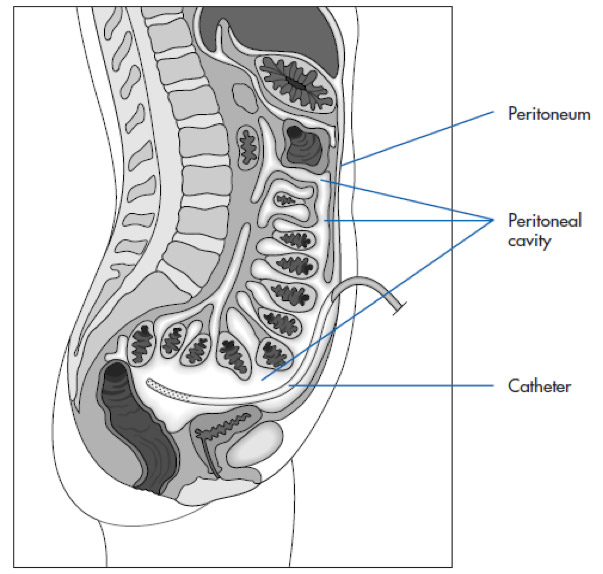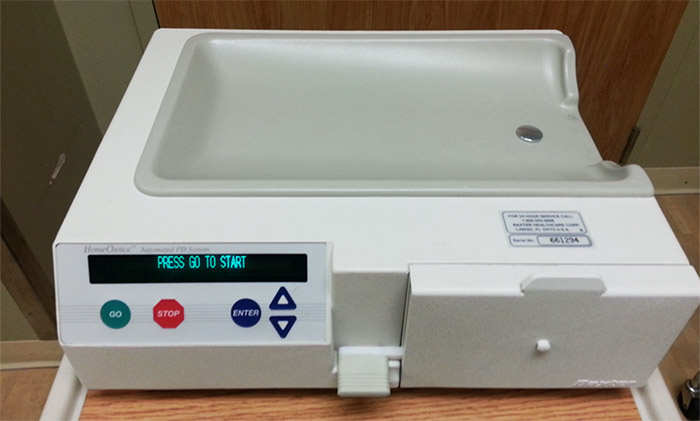Peritoneal dialysis
How peritoneal dialysis (PD) works
Peritoneal dialysis is a way of cleaning your blood by using the peritoneal membrance (inside of the belly) and dialysis fluid.
You will need to have a catheter surgically placed in your belly before you begin dialysis. Dialysis fluid is exchanged in the belly multiples times to clean blood.
Peritoneal cavity and catheter

Image courtesy of The Kidney Foundation of Canada
Peritoneal dialysis can be be performed at home. It can be done at night using a machine (cycler) and/or throughout the day without a machine (manually). Space is required for supplies.
Peritoneal dialysis cycler machine

Training and supports
- Home dialysis nurses and technical support are on-call 24/7
- Home care nurses (CCAC) will be available to assist with peritoneal dialysis
- Routine home visits and telephone calls from home dialysis team
- Clinic visits with your kidney team are required every 1-2 months
Why might I consider peritoneal dialysis?
- Travel is possible
- Flexibility of time
- Avoids frequent travel to a dialysis unit
- Needles not required for dialysis treatments
- Decreased impact on work/life/social activities
What are common risks on peritoneal dialysis?
- Infection: at the catheter exit site or the fluid inside the belly (peritonitis)
- Average risk of peritonitis is about 1 every 3-4 years of therapy
- Catheter blockage: from constipation or change in the catheter tip position over time
- Repositioning of catheter tip may need to be fixed in the X-ray department
- Due to infection, blockage, or other complications, some patients may need to switch from peritoneal dialysis to hemodialysis
Learn more
1. Peritoneal dialysis – the basics
Our interprofessional team
- Our home dialysis team includes a nephrologist (kidney doctor), nurses, dialysis access coordinator, dietitian, social worker, pharmacist, patient care manager and administrative assistant
- We work together to manage the health care needs of individuals on dialysis
Types of dialysis
There are two types of dialysis:
- Peritoneal dialysis (PD) = Belly dialysis
- Hemodialysis (HD) = Blood dialysis
We work with individuals to determine the type of dialysis that is most suitable for them
How PD works

Image courtesy of The Kidney Foundation of Canada
- The inside of the abdomen (belly) is called the peritoneal cavity. This cavity is lined with a thin membrane called the peritoneum
- A sterile dialysis fluid is put into the peritoneal cavity through a PD catheter (flexible tube) that has been surgically inserted
- The PD catheter provides long-term access to the peritoneal cavity
- The dialysis fluid stays in the peritoneal cavity for a prescribed time for the filtering process
- During filtering, the extra water and waste products from the blood shift into the peritoneal cavity through the peritoneum
- Extra water and waste products are then drained from the peritoneal cavity through the PD catheter
PD catheter
- One end of the catheter rests in the peritoneal cavity while the other extends from the body by about 4 inches so that it can be attached to the dialysis tubing
- This end is sealed off when PD fluid is not being flushed in and out of the peritoneal cavity
Inserting the PD catheter
- Dialysis access coordinator arranges for insertion of the PD catheter and explains preparation and follow-up
- The catheter is inserted into the belly by a specialist in medical imaging (X-ray) department
- Intravenous sedation and a local anaesthetic are given
- Most individuals describe the insertion as an uncomfortable procedure but not painful
- After the catheter is inserted, it is covered with a dressing which is changed weekly. The insertion site takes about 3 weeks to heal before the catheter can be used
2. Types of peritoneal dialysis
Types of PD
There are 2 different types of PD:
- Continuous Ambulatory Peritoneal Dialysis (CAPD): No machine is required
- Continuous Cycler Peritoneal Dialysis (CCPD): A cycler machine is required
CAPD
- An exchange is the process of draining the peritoneal cavity of used dialysis fluid and filling it with fresh dialysis fluid
- Exchanges are performed manually (by hands) throughout the day
- Up to 2 litres of dialysis fluid is left in the peritoneal cavity
CCPD
- The cycler performs exchanges every night while you sleep
- The cycler usually runs for 9 hours
- During the day, some fluid is left in the peritoneal cavity
Why might I consider peritoneal dialysis?
- Flexibility of time
- Convenience in travel
- Avoids travel to a dialysis unit
- Decreased impact on work/life/social activities
- Needles not required for dialysis treatments
3. Risks of peritoneal dialysis
Infection
- The home dialysis nurses teach individuals on PD how to keep the PD catheter exit site clean and perform exchanges without causing an infection
- However, some individuals may experience infections at the exit site or infection of fluid inside the belly (peritonitis)
- The average risk of peritonitis is about 1 every 3 to 4 years of PD therapy
PD catheter blockage
- The PD catheter is checked at the time of insertion to ensure it works well
- Some catheters can become blocked because of constipation or if the position of the catheter tip moves over time
- This problem may be solved by treating constipation or changing position during PD exchanges
- In some cases, the PD catheter tip has to be repositioned in the medical imaging (X-ray) department
Transfer from PD to HD
- Some individuals have to transfer from PD to HD
- Common reasons for transfer are infection, poor healing around the exit site (leaks), blocked PD catheters and need for abdominal surgery
- Approximately 25% of individuals on PD transfer to HD after 2 years of therapy
- Some of these individuals are able to return to PD after a period of HD
4. Eligibility for peritoneal dialysis
Individual and/or caregiver requirements
- Willingness and ability to learn peritoneal dialysis at home
- Basic English reading and writing skills
- Ability to perform certain tasks easily by hand
- Adequate vision to operate equipment (Cycler machine)
Home requirements
- Clean and well lit room
- Space for cycler machine, reclining chair/bed, work table and storage of monthly supplies (requires approximately 5ft X 5ft area) and increased garbage
- Weighing scale, blood pressure monitor
- Hand sanitizer
- Telephone and backup lighting (flashlight)
- Larger garbage bins may be required (a letter to city can be provided)
5. Education and support for peritoneal dialysis
PD training
- One on one training is provided by a home dialysis nurse in our home dialysis unit
- Approximately 5 days of training are required to learn how to manage PD
- Free parking is provided during the training sessions
- Our nurses work with individuals and their families to schedule training days
- Re-training can also be provided as necessary
Clinic
- Visits to home dialysis clinic are generally required every month initially and then every 2 months
- Visits to home dialysis unit are scheduled as needed
Nursing and home visits
- Individuals on PD can call home dialysis team during office hours
- Outside of regular office hours
- A home dialysis nurse is on-call 24/7
- Technical support for the PD cycler is available 24/7
- Home visits by home dialysis nurses can be provided as needed
- Visits by home care nurses are available up to twice a day as needed
Supplies and storage
- Supplies (dialysis fluid, tubing and etc.) are delivered monthly to individual’s residence
- About 30-60 boxes of supplies are delivered each month. Boxes can be stored at room temperature. Under certain circumstances, smaller, more frequent deliveries are possible which require less storage space
- Nurses teach patients and/or families how to order supplies
Garbage disposal
- Supplies are disposable and can be thrown in the regular garbage
- Cardboard boxes are recyclable
- A letter to request for bigger garbage bin will be provided if needed
6. Life on peritoneal dialysis
CAPD: daily routine
Individuals on CAPD:
- Perform daily assessment (monitor weight, blood pressure, and fluid status i.e. swelling)
- Care for site around the PD catheter
- Perform approximately 4 exchanges per day (each exchange takes about 45 minutes)
Individuals on CCPD:
- Perform daily assessment (monitor weight, blood pressure, and fluid status i.e. swelling)
- Care for site around the PD catheter
- Set-up the cycler (it takes15 - 20 minutes any time prior to therapy)
- Connect to the cycler in the evening
- Disconnect from the cycler in the morning
Finances
- Most individuals are able to continue working
- Limited financial assistance may be available and some costs are tax deductible
Nutrition
- Some aspects of diet that may need to change include: protein, phosphorous, potassium, fluid and sodium
- Nutrition needs are unique for each individual and will be assessed by our dietitian. The dietitian will help in making food choices to meet those needs
- Each individual’s nutrition needs depend on many factors including: dialysis prescription, other illnesses, blood tests and the individual’s overall nutritional health
Medications
- When starting PD, adjustments to the medication dose and timing may be needed as some are removed from the body through dialysis
- Individuals on PD should check with their pharmacist before starting any new medication, supplement or natural product to ensure that it is safe and dosed appropriately
- While on PD, there may be times when medication needs to be added into the PD bags
Possible medication changes when starting PD:
- Individuals with diabetes may experience increases in blood sugar levels and may need adjustments to diabetes medications
- Individuals may be started on medications to help maintain a normal bowel routine which is important to ensure that PD works properly
Travel
- Dialysis fluid and supplies can be delivered to a wide range of destinations around the world. These are arranged through the company that manufactures them
- Most airports, ports, stations, and large tourist attractions have a medical room, where it should be possible to carry out a CAPD exchange
- Planning is key to successful travel
Body image
PD catheter
- PD catheter is visible outside of the belly. It can be held in place with a PD belt or by other means
- Although individuals may feel self-conscious at first, they often get used to it
Weight gain
- PD dialysis fluid contains dextrose (sugar) to remove excess fluid. Some sugar may be absorbed, causing some individuals to experience weight gain. Our dietitian can discuss strategies for this issue
Lifestyle
- Individuals on PD should avoid lifting items over 25 lbs (10 kg)
- The PD catheter should be secured and protected during physical exertion such as manual work or exercise
- Swimming is allowed but only in clean bodies of water such as pools.
- Good bowel routine and avoiding constipation is important
Intimacy and pregnancy
Intimate relationships
- Individuals on peritoneal dialysis may continue having an intimate relationship
- Kidney disease may affect sexual desires and/or activity
- Individuals who are interested in more information should talk to a member of the interprofessional team
Pregnancy
- Men and women on dialysis may be able to have children
Relationships and mood
- Individuals may experience a wide range of emotions and are encouraged to speak with interprofessional team members
- Sharing experiences, feelings and concerns often helps strengthen personal relationships and resolve difficulties
- Peer Support is available through the Kidney Foundation of Canada






